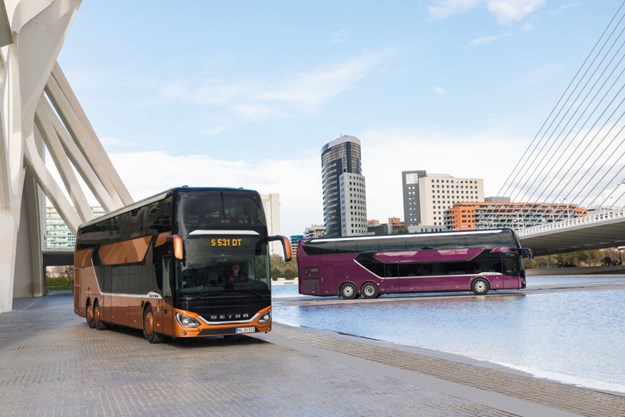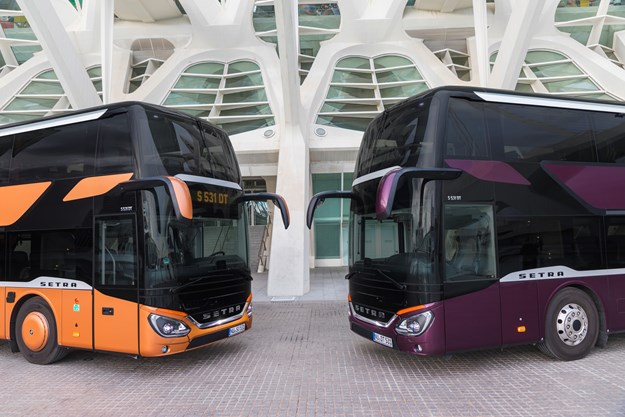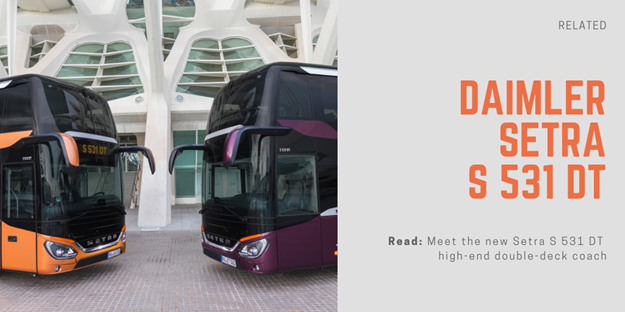DAIMLER’S FLAGSHIP premium double-deck coach – the 12.8-litre, 375kW (510hp) Setra S 531 DT – has embarked on a special five-day media ‘test tour’ throughout North-East Europe, 11-16 March, 2019.
From Berlin, Germany, to Tallinn, Estonia, the 2000-kilometre journey is to give local bus publications the chance to give the new double-decker touring coach an “acid test”, with media able to drive it at various stages.
Staring in Germany then via Poland, Lithuania and Latvia all the way to Estonia, the international test drive across four borders will offer nearly two dozen participating journalists exclusive driving impressions and new glimpses into the world of bus travel comfort, says Daimler.
After passing the Victory Column and the Brandenburg Gate, the eastbound journey will commence its first stage towards Warsaw.
During the 571 kilometres en route to the Polish capital, reviewers will all take turns behind the wheel and have the opportunity to become acquainted with the new Setra on the first day of the journey. After arriving in Warsaw, the new assistance systems Active Brake Assist 4 and Sideguard Assist was to be presented at the Warsaw Bus exhibition in a driving demonstration on the second day.

LENGTHY STAGES
From Warsaw, the journey heads to Vilnius, the Lithuanian capital. During this 582-kilometre-long stage, reviewers will have sufficient time to experience the coach from behind the wheel and as actual passengers, notes Daimler.
On the fourth day, the journey will continue further north – with Riga as the stage’s next destination after 472 kilometres. The Lithuanian capital is located directly at the estuary, where the Daugava merges with the Baltic Sea and offers uniquely picturesque sights. On the last day of the test drive, there are another 312 kilometres to be driven and many of them directly along the coast line of the Baltic Sea. The last destination is Tallinn, the Estonian capital.
.jpg)
COACH TOURISM GROWTH
Why this area? According to Daimler, whether as a chartered coach or for use in scheduled long-distance bus transportation, Poland and the Baltic States are becoming increasingly important markets for coaches.
Overall, the importance of Eastern Europe for the coach segment has increased significantly over the past decade, the company states. In the Eastern European EU states alone, manufacturers were able to sell around 1400 coaches last year. Compared to 10 years ago, that’s an increase of more than 60 per cent. From 2017 to 2018, the market once again increased by more than 11 per cent, Daimler reports.
Especially in Eastern Europe, it’s fully in trend to take the bus – but certainly not only there, as proven by the success of long-distance bus service operators in Western Europe and in the German market after its “liberalisation” in 2013, says Daimler.
As the company explains, there are numerous reasons for the strong growth in Eastern Europe. For passengers, the bus traditionally is a cost-effective, comfortable and safe means of transportation. Many medium-sized cities, which are not or only badly connected by train, now have direct bus connections to the major European cities. And the major metropolitan areas are also connected to each other with scheduled bus services that often run several times a day.
Finally, the entire regional market for buses is growing in Eastern Europe, it states.
Furthermore, says Daimler, the coach also scores points in terms of climate policy; In Germany, the Federal Environment Agency (Umweltbundesamt) has certified that coaches have a comparatively low rate of greenhouse gas emissions at around 30 grams of CO2 per passenger kilometre.
By comparison, long-distance railway traffic was certified a CO2 emissions rate of 45 grams per passenger kilometre.




